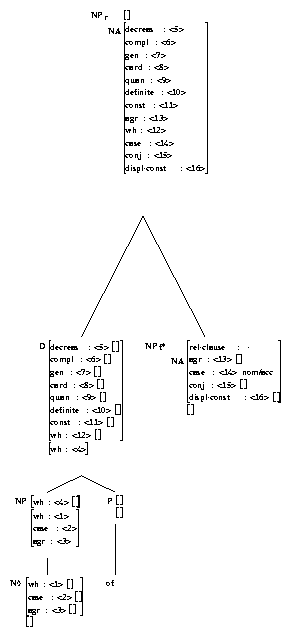
In other words, for partitive constructions, the semantic head of the NP is the second rather than the first noun in linear order. That the agreement shown in ((326)) is possible suggests that the second noun in linear order in these constructions should also be treated as the syntactic head. Note that both the partitive and PP readings are usually possible for a particular NP. In the cases where either the partitive or the PP reading is preferred, we take it to be just that, a preference, most appropriately modeled not in the grammar but in a component such as the heuristics used with the XTAG parser for reducing the analyses produced to the most likely. In our analysis the partitive tree in Figure 19.6 is anchored by one of a limited group of nouns that can appear in the determiner portion of a partitive construction. A rough semantic characterization of these nouns is that they either represent quantity (e.g. part, half, most, pot, cup, pound etc.) or classification (e.g. type, variety, kind, version etc.). In the absence of a more implementable characterization we use a list of such nouns compiled from a descriptive grammar [#!quirk85!#], a thesaurus, and from online corpora. In our grammar the nouns on the list are the only ones that select the partitive determiner tree.
 |
Like other determiners, partitives can adjoin to an NP consisting of just a noun (`[a certain kind of] machine'), or adjoin to NPs that already have determiners (`[some parts of] these machines'. Notice that just as for the genitives, the complexity and the recursion are contained below the D node and rest of the structure is the same as for simple determiners.